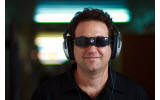Sound rather than sight can activate 'seeing' for the blind
Sound rather than sight can activate 'seeing' for the blind, say Hebrew University researchers. Scientists at the Faculty of Medicine have tapped onto the visual cortex of the congenitally blind by using sensory substitution devices (SSDs), enabling the blind in effect to “see” and even describe objects. SSDs are non-invasive sensory aids that provide visual information to the blind via their existing senses. For example, using a visual-to-auditory SSD in a clinical or everyday setting, users wear a miniature video camera connected to a small computer (or smart phone) and stereo headphones. The images are converted into “soundscapes,” using a predictable algorithm, allowing the user to listen to and then interpret the visual information coming from the camera. Remarkably, proficient users who have had a dedicated (but relatively brief) training as part of a research protocol in the laboratory ofDr. Amir Amedi, of the Edmond and Lily Safra Center for Brain Sciences and theInstitute for Medical Research Israel-Canada at the Hebrew University, are able to use SSDs to identify complex everyday objects, locate people and their postures, and read letters and words. In addition to SSDs’ clinical opportunities, using functional magnetic resonance imaging opens a unique window for studying the organization of the visual cortex without visual experience by studying the brain of congenitally blind individuals. The results of the study in Amedi’s lab, recently published in the journal Cerebral Cortex, are surprising. Not only can the sounds, which represent vision, activate the visual cortex of people who have never seen before, but they do so in a way organized according to the large-scale organization and segregation of the two visual processing streams. For the past three decades, it has been known that visual processing is carried out in two parallel pathways. The ventral occipito-temporal “what” pathway, or the “ventral stream,” has been linked with visual processing of form, object identity and color. Its counterpart is considered to be the dorsal occipito-parietal “where/how” pathway, or the “dorsal stream,” which analyzes visuo-spatial information about object location and participates in visuo-motor planning. Although this double dissociation between the processing of the two streams has been thoroughly validated, what remained unclear was the role of visual experience in shaping this functional architecture of the brain. Does this fundamental large-scale organizational principle depend on visual experience? Using a sensory substitution device developed by Peter Meijer and called “The vOICe”, the Hebrew University scientists, led by Ph.D. student Ella Striem-Amit and Dr. Amedi, discovered that the visual cortex of the blind shows a similar dorsal/ventral visual pathway division-of-labor when perceiving sounds that convey the relevant visual information; e.g., when the blind are requested to identify either the location or the shape of an SSD “image,” they activate an area in the dorsal or in the ventral streams, respectively. This shows that the most important large-scale organization of the visual system into the two streams can develop at least to some extent even without any visual experience, suggesting instead that this division-of-labor is not at all visual in its nature. Recent research from Amedi’s lab and from other research groups have demonstrated that multiple brain areas are not specific to their input sense (vision, audition or touch), but rather to the task or computation they perform, which may be computed with various modalities. Extending these finding to a large-scale division-of-labor of the visual system further contributes crucial information towards postulating that the whole brain may be task-specific rather than dependent on a specific sensory input. ''The brain is not a sensory machine, although it often looks like one; it is a task machine,'' summed up Amedi. These findings suggest that the blind brain can potentially be “awakened” to processing visual properties and tasks, even after lifelong blindness, with the aid of visual rehabilitation, using future medical advances, such as retinal prostheses, say the researchers. A summary of these ideas were published recently in a review in Current Opinion in Neurology by Lior Reich and Shachar Maidenbaum from Amedi’s lab. http://www.dailymail.co.uk/sciencetech/article-2100398/Real-life-science-closes-Star-Trek-TNG-new-device-hack-blind-peoples-visual-cortex-let-see.html


